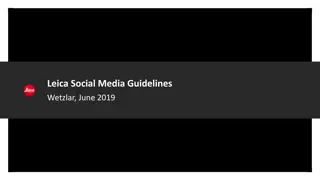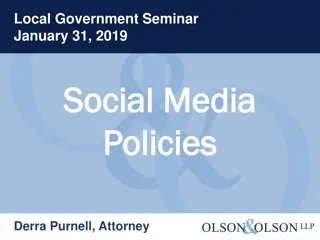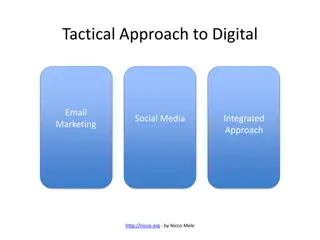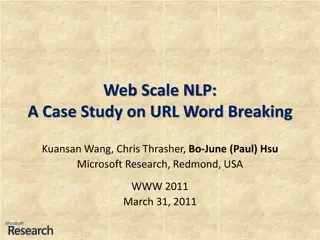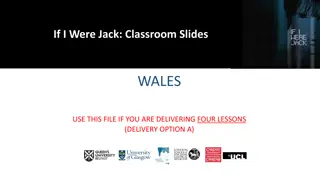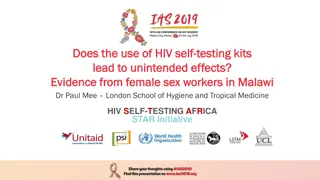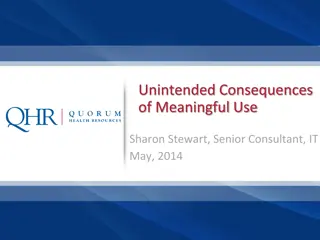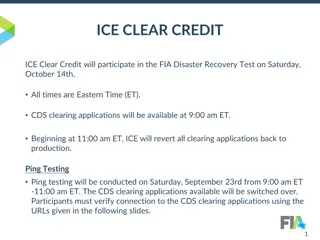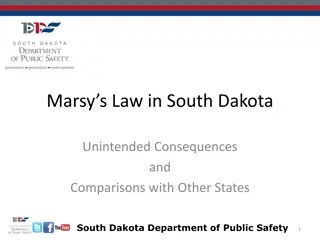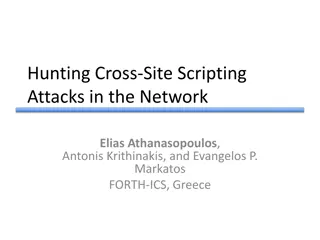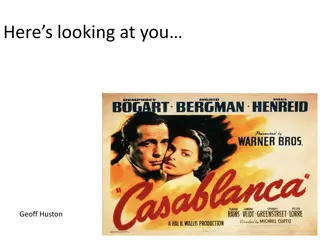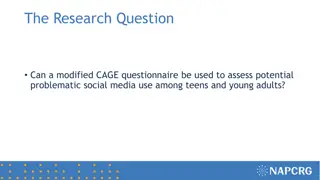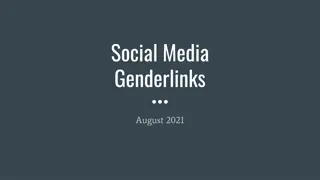Understanding the Threat of Unintended URLs in Social Media
Characterising the potential threat posed by unintended URLs in social media, this study identifies the risk stemming from automatic rendering of clickable links. The research delves into the background of Top Level Domains (TLDs), the issue of unintended URLs caused by forgotten spaces, and proposes a solution involving a Machine Learning Classifier to differentiate between intended and unintended URLs. The proposed solution aims to mitigate the risk of users being exposed to malicious content through inadvertently clicking on misleading links.
Download Presentation

Please find below an Image/Link to download the presentation.
The content on the website is provided AS IS for your information and personal use only. It may not be sold, licensed, or shared on other websites without obtaining consent from the author. Download presentation by click this link. If you encounter any issues during the download, it is possible that the publisher has removed the file from their server.
E N D
Presentation Transcript
To Err.Is Human: Characterising the Threat of Unintended URLs in Social Media Authored by Beliz Kaleli et al. Presented today by Denise Jarry
Motivation Social media platforms are huge and are growing Ideal target for attackers This article has found an attack vector with the way clickable links are automatically rendered
Background Top Level Domain (TLD) The last label in a domain name Some TLDs are valid dictionary words (e.g. it, online) www.twitter.com Clickable link rendering Automatically identify text that corresponds to a clickable link On Twitter, last substring needs to be a valid TLD Unintended URLs According to authors, they are caused by forgetting a space after a full stop: typo
Problem 1. Bob follows Alice 2. Alice makes a tweet with a typo creating an unintended URL 3. Mallory sees the tweet, registers the domain, populates with malicious content 4. Bob sees the tweet and clicks the link 5. Bob is exposed to the malicious content Content could be: Politically damning (like Rudy Giuliani) Defamatory or offensive A phishing site Bob might trust the content because he thinks it was posted by Alice!
Solution Machine Learning Classifier that can distinguish between intended and unintended URLs Authors used it to conduct an analysis of the problem Implemented as a browser extension to warn users when they write a Tweet
Machine Learning Classifier Labelled Intended URL Unlabelled Classifier Unknown tweets with a URL Classification Decision Unintended URL Labelled training data ground truth dataset
Machine Learning Classifier Labelled Intended URL Prefiltering Step Unlabelled Classifier Heuristics to bypass classifier Unknown tweets with a URL Tweet filtered out if URL: starts with www ends with .com or .org has TLD that is a non-dictionary word Classification Decision Unintended URL These heuristics immediately identify an intended URL Labelled training data aka ground truth dataset
Machine Learning Classifier Labelled Classifier Intended URL Training Data Unlabelled Classifier compares features of unlabelled tweet with features in the training data to make a classification decision Classifier Unknown tweets with a URL Classification Decision How training data was collected: Sample of tweets from Twitter API Passed through pre-filtering Only want to include data relevant to the classification decision 1,068 tweets collected Authors discussed and come to agreement on labels 644 intended, 424 unintended Unintended URL 1,068 tweets Labelled training data aka ground truth dataset
Machine Learning Classifier Labelled Intended URL Unlabelled Classifier Unknown tweets with a URL Classification Decision Unintended URL Labelled training data aka ground truth dataset 94% Accuracy
Problem Analysis Ran for 7 months Authors used the classifier to analyse tweets as they were posted in real time Key Findings 26,596 unintended URLs posted on Twitter Most common domain names: d.va, b.tech Reasons other than typos Video game character (d.va) Instagram handles have full stops This can create a URL when posted on Twitter Common acronyms (b.tech) False positive Not a typo
Problem Analysis: URL Content Crawler looked at the content of the unintended URL websites Content of unintended URL websites Concerning: 39.5% of the URLs they crawled led to domain parking webpages Previous work has shown that domain parking webpages commonly serve malicious content
Problem Analysis: URL Registration Date Registration date of unintended URL domains Most registered up to 5 years ago There was no attack here the poster just accidentally typed a registered domain Spike in registrations at day 0 Suggests an attack!
Browser Extension TypoNoMo Chrome extension JavaScript Click handler on Tweet button Passes the text through the pre-filtering Runs the pre-trained classifier Makes a classification decision Intended or unintended? Shows warning message if unintended URL is detected
Browser Extension Performance Impact Multiple scenarios tested No URLs 1 URL 2 URLs 3 URLs Worst case scenario 3 URLs = 3 classification tasks Results in just under 1 second delay Most users would only rarely see the popup Authors argue it does not impact UX They think Twitter should implement it natively
Issues Prefilters URLs with non-dictionary TLDs as intended What about user misspelling? Text speech? What about domains like lol, ooo, lgbt, google, fyi, aws All considered non-dictionary words by the authors Unintended URL with non-dictionary TLD will immediately get misclassified during the prefiltering step Only 5 / 20 of the top unintended domains were due to typos Authors barely acknowledge this They push forward with the typo detecting classifier solution d.va no typo for the user to fix!
Improvements: Simpler Solution Simple! More usable feature that Twitter might actually implement
Improvements: Improve non-dictionary TLD prefiltering step Consider that humans misspell words and use text speech Authors need to increase the size of their dictionary Add TLDs like lol, ooo, lgbt, google, fyi, aws Dynamic dictionary instead of static .txt file Detects new text speech or words becoming popular online Adds them to the dictionary .txt file used as a dictionary by the browser extension






